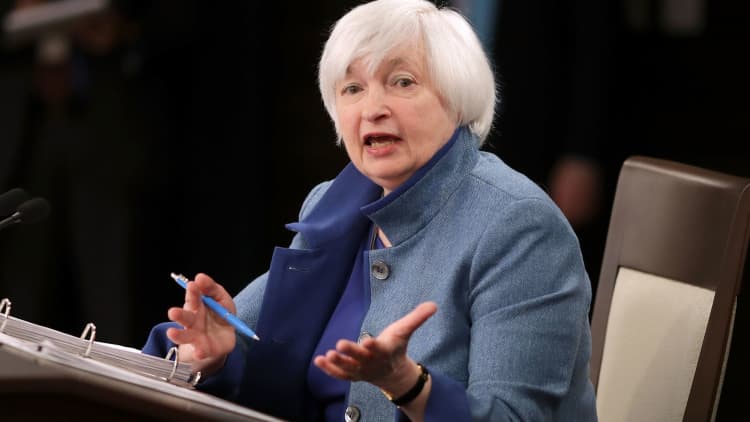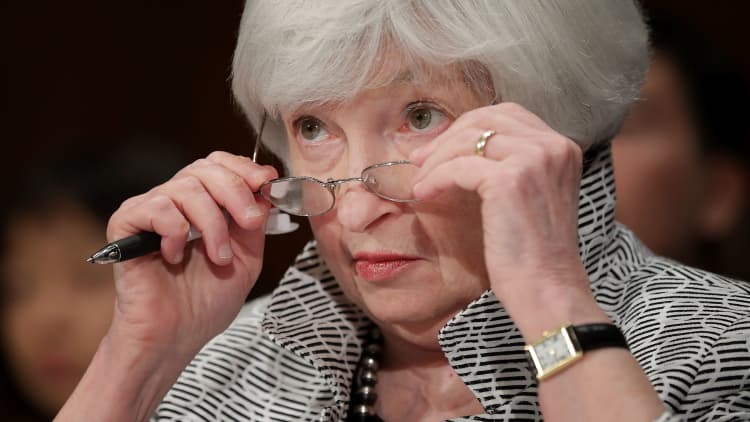
The Federal Reserve laid the groundwork Wednesday to begin winding down shortly the massive stimulus program it embarked on to rescue the economy from the financial crisis. As expected, the Fed also unanimously declined to raise interest rates this month.
After its two-day policy meeting, the Federal Open Market Committee released a statement containing key language that points to starting the move in September. At that time, the central bank will begin rolling off the $4.5 trillion portfolio of bonds it has accrued on its balance sheet, mostly in the years following the crisis and the Great Recession it generated.
"The committee expects to begin implementing its balance sheet normalization program relatively soon, provided that the economy evolves broadly as anticipated," the post-meeting statement said.
The "relatively soon" phrase is the crux of the announcement. Fed watchers had been looking for the language to change from "this year," as indicated following the June meeting, to something more immediate.
Efforts to reduce the balance sheet will entail allowing a capped level of proceeds from the bond portfolio to run off each month. The rest will be reinvested as usual. The program will start at $10 billion a month and increase quarterly to $50 billion. Fed officials estimate that once the program has run its course, the balance sheet likely still will exceed $2 trillion.
Chair Janet Yellen and others have indicated that the balance sheet runoff should not be disruptive to markets, though some fear that it could push up rates if demand for the bonds isn't strong.
"It's going to be difficult to not disrupt the markets somewhat as they start to unwind the balance sheet," said JJ Kinahan, chief market strategist at TD Ameritrade. "However, to their credit they did support the markets for the last nine years. They've done a good job of being transparent. That transparency will help smooth the way as much as possible."
The Fed expanded its balance sheet in an effort to resuscitate an economy on the brink of collapse during the crisis.
"The fact that this has been so telegraphed for so long, we think this won't cause any disruptions," said Ryan Detrick, senior market strategist at LPL Financial. "The market's taking it in stride."
In three rounds, the last of which concluded in 2014, the central bank credited itself with funds that it then used to buy debt — Treasurys and mortgage-backed securities, the latter in an effort to drive down rates on housing loans during the worst real estate market since the Great Depression.
The operation became known in the market as "money printing," though it didn't involve the physical creation of new currency.
In recent months, Fed officials have expressed a desire to decrease the balance sheet as part of a broader effort to normalize crisis-era policy.
Along with buying up bonds, the Fed kept its benchmark interest rate anchored near zero until December 2015, when it began a gradual process of hikes. The current target is between 1 percent and 1.25 percent, after four quarter-point increases.
Markets did not expect the Fed to increase rates at this meeting. Traders in the fed funds futures market are assigning about a 50-50 chance the central bank makes one more rate move before the end of the year.
In assessing the economy, the committee held to its assessment that "activity has been rising moderately so far this year." On inflation, the statement removed the word "somewhat" from June's verbiage and said simply that inflation was running "below 2 percent," a subtle tweak that nonetheless probably signifies officials are a bit more pessimistic about reaching their mandated objectives.
While the term carries negative connotations, some inflation is regarded as good for the economy. The central bank has targeted 2 percent as a desirable level, but has fallen consistently short even as the unemployment rate has dropped to 4.4 percent.
Fed officials have been flummoxed at the economy's inability to generate rising incomes that give consumers more purchasing power and raises the collective standard of living.
Average hourly wage growth has been stuck around 2.5 percent. Other inflation measures have been even lower, with the Fed's preferred gauge, the personal consumption expenditures index, at 1.4 percent.
WATCH: Gross says Fed more focused on reducing balance sheet



